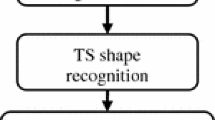Abstract
Everyday humans use cars to move faster, and the world is a chaotic place, and a little distraction or a mistake could be the reason for an accident and bring people great pain. An assistance system that can distinguish and detect signs on the roads and brings the driver's attention to road signs and make them aware of their meaning could be beneficial. The most important part of the Traffic Sign Recognition System is the algorithm. In this paper, a new way toward Traffic Sign Recognition algorithm taking the advantages of Color Segmentation, support vector machines, and histograms of oriented gradients on the GTSRB dataset is proposed. The unsupervised shuffled frog-leaping algorithm is employed for segmenting the images. The results show remarkable improvements by using meta-heuristic algorithms.

















Similar content being viewed by others
Data Availability
Data sharing is not applicable to this article as no new data were created or analyzed in this study.
References
Novak, B., Ilic, V., & Pavkovic, B. (2020). YOLOv3 Algorithm with additional convolutional neural network trained for traffic sign recognition.
Stallkamp, J., Schlipsing, M., Salmen, J., & Igel, C. (2012). Man vs. computer: Benchmarking machine learning algorithms for traffic sign recognition. Neural Networks, 32, 323–332.
Yuheng, S., & Hao, Y. (2017). Image segmentation algorithms overview. CoRR, vol. abs/1707.02051.
Sermanet, P., & LeCun, Y. (2011). Traffic sign recognition with multi-scale convolutional networks. In The 2011 international joint conference on neural networks.
Sermanet, P., Eigen, D., Zhang, X., Mathieu, M., Fergus, R., & LeCun, Y. (2013). OverFeat: Integrated recognition, localization and detection using convolutional networks. CoRR.
Stallkamp, J., Schlipsing, M., Salmen, J., & Igel, C. (2011) The German traffic sign recognition benchmark: A multi-class classification competition. In The 2011 international joint conference on neural networks.
Finlayson, G. D., Schiele, B., & Crowley, J. L. (1998). Comprehensive colour image normalization. In Computer vision—ECCV'98. Berlin.
Zaibi, A., Ladgham, A., & Sakly, A. (2021). Road sign detection using edited shuffled frogs leaping algorithm. International Journal of Vehicle Safety, 12(1), 1–14.
Haque, W. A., Arefin, S., Shihavuddin, A. S. M., & Hasan, M. A. (2021). DeepThin: A novel lightweight CNN architecture for traffic sign recognition without GPU requirements. Expert Systems with Applications, 168, 114481.
Maaroof, B. B., Rashid, T. A., Abdulla, J. M., Hassan, B. A., Alsadoon, A., Mohamadi, M., & Mirjalili, S. (2022). Current studies and applications of shuffled frog leaping algorithm: A review. Archives of Computational Methods in Engineering, 1–16.
Toth, Š. (2012). Difficulties of traffic sign recognition. In Mathematics applied to ICT.
Eusuff, M., Lansey, K., & Pasha, F. (2006). Shuffled frog leaping algorithm: A memtic meta heuristic for discrete optimization. Engineering Optimization, 38, 129–154.
Ellahyani, A., Ansari, M. E., & Jaafari, I. E. (2016). Traffic sign detection and recognition based on random forests. Applied Soft Computing, 46, 805–815.
Tungkasthan, A., & Premchaiswadi, W. (2011). Automatic region of interest detection in natural images.
Ebrahimzadeh, R., & Jampour, M. (2014). Efficient handwritten digit recognition based on histogram of oriented gradients and SVM. International Journal of Computer Applications, 104, 10–13.
Tehami, A., & Hadria, F. (2017). Unsupervised segmentation of images based on shuffled frog-leaping algorithm. JIPS, 13, 370–384.
Dalal, N., & Triggs, B. (2005). Histograms of oriented gradients for human detection. In 2005 IEEE computer society conference on computer vision and pattern recognition (CVPR'05).
Horng, M. (2013). Multilevel image threshold selection based on the shuffled frog-leaping algorithm. Journal of Chemical and Pharmaceutical Research, 5(9), 599–605.
Zhu, Z., Liang, D., Zhang, S., Huang, X., Li, B., & Hu, S. (2016). Traffic-sign detection and classification in the wild. In 2016 IEEE conference on computer vision and pattern recognition (CVPR), Las Vegas, Nevada, USA.
Lafuente-Arroyo, S., Gil-Jimenez, P., Gomez-Moreno, H., & Lopez-Ferreras, F. (2007). Road-sign detection and recognition based on support vector machines. IEEE Transactions on Intelligent Transportation Systems, 2, 264–278.
Kolivand, H., Joudaki, S., Sunar, M. S., & Tully, D. (2020). A new framework for sign language alphabet hand posture recognition using geometrical features through artificial neural network (part 1). Neural Computing and Applications. https://doi.org/10.1007/s00521-020-05279-7
Krizhevsky, A., Sutskever, I., & Hinton, G. E. (2012). ImageNet classification with deep convolutional neural networks. In F. Pereira, C. J. C. Burges, L. Bottou, & K. Q. Weinberger (Eds.), Advances in neural information processing systems 25 (pp. 1097–1105). Curran Associates, Inc.
Jain, A., Mishra, A., Shukla, A., & Tiwari, R. (2019). A novel genetically optimized convolutional neural network for traffic sign recognition: A new benchmark on Belgium and Chinese traffic sign datasets. Neural Processing Letters, 50(3), 3019–3043.
Kolivand, H., Joudaki, S., Sunar, M. S., & Tully, D. (2021). An implementation of sign language alphabet hand posture recognition using geometrical features through artificial neural network (part 2). Neural Computing and Applications, 33, 13885–13907.
Cinar, I., Taspinar, Y. S., Saritas, M. M., & Koklu, M. (2020). Feature extraction and recognition on traffic sign images. Journal of Selcuk-Technic Özel Sayı 2020 (ICAT’20) Special, 19, 282–292.
Funding
There is no funding received for this research work.
Author information
Authors and Affiliations
Corresponding author
Ethics declarations
Conflict of interest
The authors declare that they have no conflict of interest.
Additional information
Publisher's Note
Springer Nature remains neutral with regard to jurisdictional claims in published maps and institutional affiliations.
Rights and permissions
About this article
Cite this article
Demokri Dizji, P., Joudaki, S. & Kolivand, H. A New Traffic Sign Recognition Technique Taking Shuffled Frog-Leaping Algorithm into Account. Wireless Pers Commun 125, 3425–3441 (2022). https://doi.org/10.1007/s11277-022-09718-7
Accepted:
Published:
Issue Date:
DOI: https://doi.org/10.1007/s11277-022-09718-7




